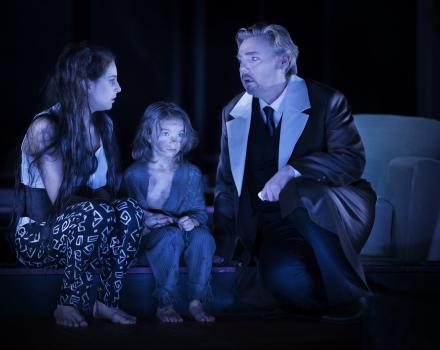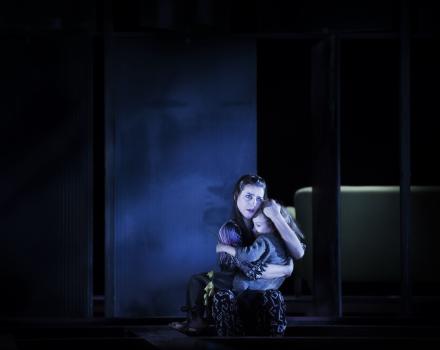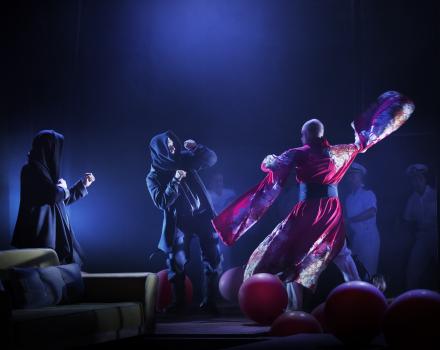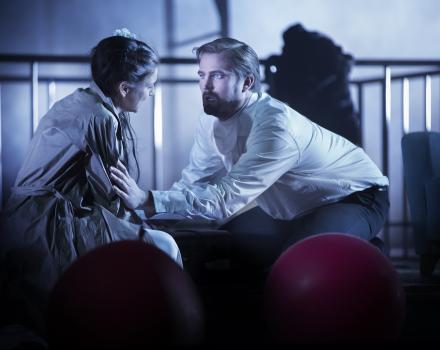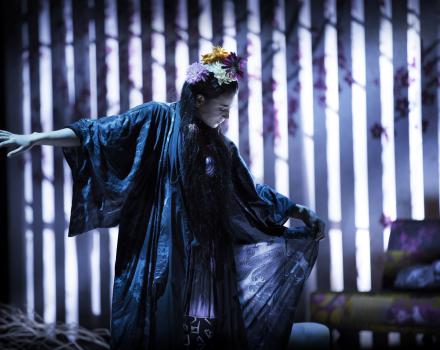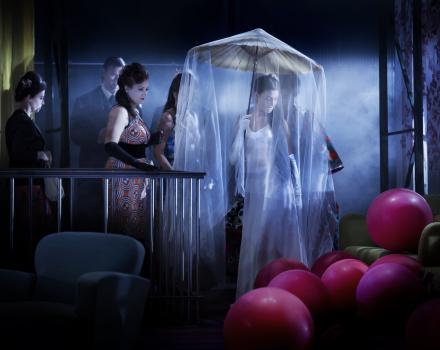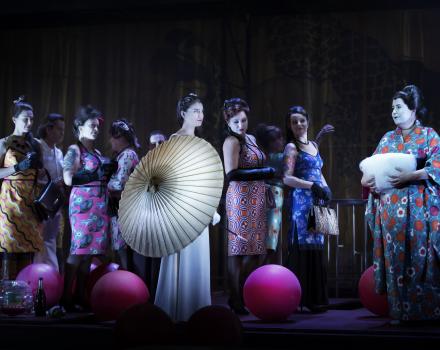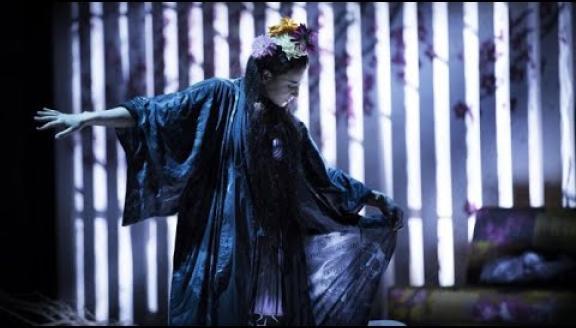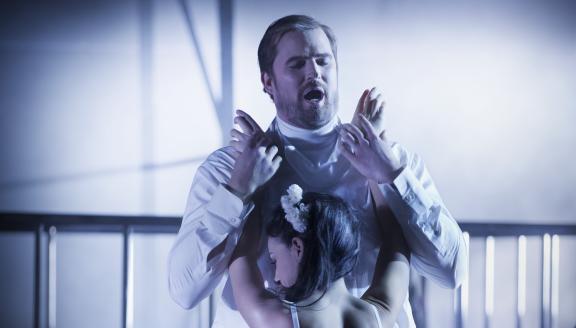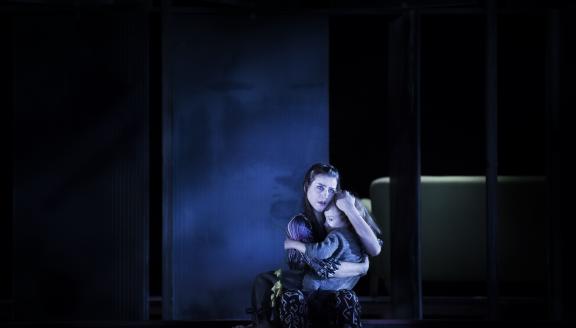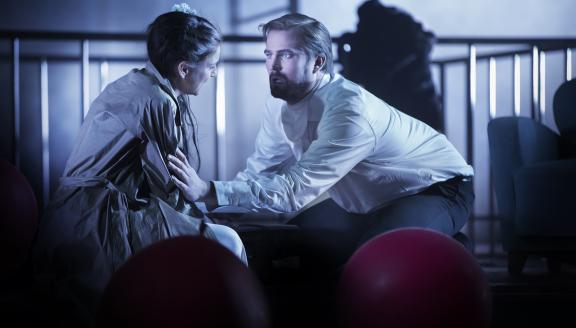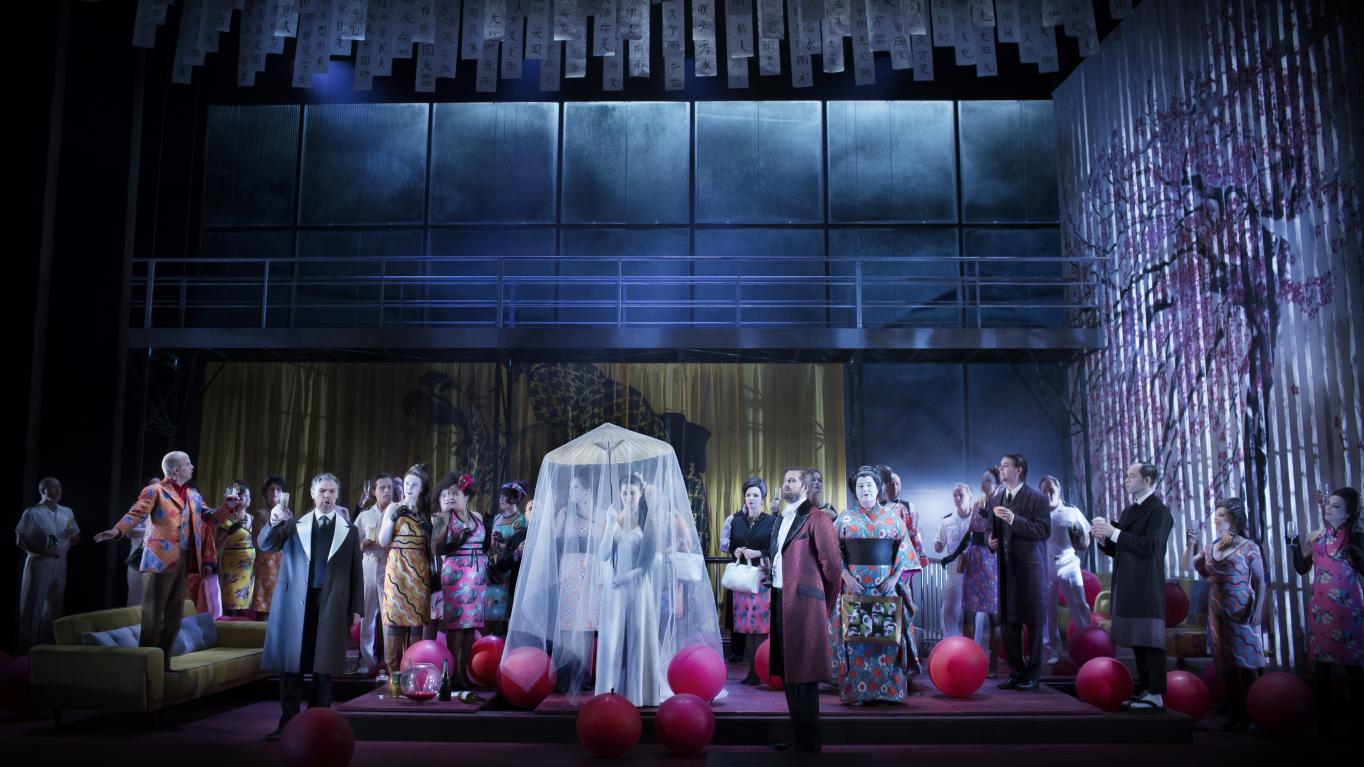

A guileless Japanese girl gives up everything to marry a lieutenant in the US Navy. But when he suddenly leaves the country, she is determined to wait patiently until he sails back into harbour.
The last of Puccini’s ‘big three’ operas, Madama Butterfly is as beautiful as it is heartbreaking. Lithuanian soprano Asmik Grigorian sings the title role in this colourful production from the Royal Swedish Opera set amongst the glitz and kitsch of postwar Japan.
This opera replaces Fedora in a change to OperaVision’s planned schedule.
Cast
Cio-Cio-San | Asmik Grigorian |
|---|---|
Suzuki | Katarina Leoson |
Lieutenant B. F. Pinkerton | Daniel Johansson |
Sharpless | Karl-Magnus Fredriksson |
Goro | Niklas Björling Rygert |
Prince Yamadori | Magnus Kyhle |
Kate Pinkerton | Kristina Hanson |
Bonze, Cio-Cio-san's uncle | John Erik Eleby |
Yakuside, Cio-Cio-san's uncle | Ian Power |
The Official Registrar | Henrik Hugo |
The Imperial Commissioner | Andreas Lundmark |
Cio-Cio-san's mother | Kristina Wennberg |
Cio-Cio-san's cousins | Cecilia Nannesson, Jessica Forsell Clarhäll |
Cio-Cio-san's aunt | Anna Danielsson |
Cio-Cio-san's child | John Österlund |
Chorus | Royal Swedish Opera Chorus |
Orchestra | Royal Swedish Orchestra |
| ... | |
Music | Giacomo Puccini |
|---|---|
Conductor | Lawrence Renes |
Director | Kirsten Harms |
Sets | Herbert Murauer |
Lighting | Torben Lendorph |
Costumes | Herbert Murauer |
Text | Luigi Illica, Giuseppe Giacosa |
Concertmaster | Tale Olsson |
| ... | |
Video
The story
Act I
An officer in the American navy, B.F. Pinkerton, has fallen in love with Cio-Cio-San during his visit to Japan. Their wedding is about to take place in the house which Pinkerton has rented through the marriage contractor, Goro. Amongst the guests are Butterfly’s mother and relatives, her maid Suzuki and the American consul Sharpless. Sharpless asks Pinkerton to treat his young bride gently and take her love seriously. Pinkerton takes his warnings lightly: when two people fall in love, they cannot concern themselves with the future. Cio-Cio-San, whose name means Butterfly in Japanese, shows the contents of her suitcase to Pinkerton: statuettes of her ancestors, and a knife. When Pinkerton asks about the knife, Goro tells him that Butterfly’s father used it to commit harakiri. Since he passed away, Butterfly has earned her living as a geisha. Butterfly’s uncle, who is a Bonze – a Buddhist priest – enters, cursing Butterfly for abandoning her ancestry and her religion. The Bonze commands all of Butterfly’s relatives to leave the party and casts her out forever. Butterfly is crushed, and hopes that Pinkerton loves her enough to stay with her. Butterfly and Pinkerton seek comfort in each others’ embrace. However, their wedding night is overshadowed by the Bonze’s curse.
Act II
Butterfly waits in the ruined house, where Pinkerton abandoned her three years ago. Money is running short and Suzuki voices her doubt that Pinkerton will ever come back. Butterfly conjures up the memory of his promise to return as soon as the robin builds his nest. Sharpless pays a visit. Pinkerton is on his way, but Sharpless hesitates to tell Butterfly the truth – that Pinkerton has married an American woman. Goro attempts to convince her to marry prince Yamadori, who has courted Butterfly for a long time without success. When Sharpless makes her understand that Pinkerton will not come back to her, Butterfly presents her child by Pinkerton to Sharpless. She begs him to let her lover know about the child: he was born after Pinkerton’s departure. Pinkerton’s ship appears in the harbour. Butterfly is in a rush to prepare for his arrival, and Suzuki helps her decorate the house with cherry blossoms. They wait up all night for him.
Act III
When the sun rises, Butterfly and her child fall asleep. Both are weary from the nightwatch. Sharpless arrives with Pinkerton and Pinkerton’s wife Kate. They have come to pick up the child to give it a better future. When Suzuki tells Pinkerton about Butterfly’s patience and loyalty, Pinkerton asks Sharpless to bring him the child and pay Butterfly off. He is unable to face her again. Butterfly enters looking for Pinkerton, and is confronted with his wife. Sharpless informs her that Pinkerton and Kate have come to take her child away. Butterfly decides to obey Pinkerton’s wish and surrender the child. When Butterly is left alone she pulls out the knife which was the instrument of her father’s suicide, and takes her life. Pinkerton rushes into the house while calling out her name.
Insights
5 things to know about Madama Butterfly
1° Far-reaching origins
Puccini chose the subject of his sixth opera after attending a performance of Madame Butterfly: A Tragedy of Japan, a one act drama by David Belasco, in London in June 1900. Belasco had, in turn, borrowed the subject matter for his drama from American writer John Luther Long’s short story Madame Butterfly, published in 1898. Long’s story is based on the memories of his sister Jennie Correll, who had travelled to Japan with her husband, a Methodist missionary, and was influenced by Pierre Loti's 1887 novel Madame Chrysanthème. Although Puccini neither understood English, nor ever set foot in Japan, he was so inspired by Belasco’s play that he felt the urge to turn it into an opera.
2° From failure to success
Before becoming one of the world’s best-loved and most-staged operas, Puccini composed five different versions of it. The original version in two acts premiered on 17 February 1904 at La Scala in Milan. Often attributed to its late completion and insufficient rehearsal time, the premiere was a huge flop and therefore quickly withdrawn. Puccini substantially revised the score, dividing the second act into two separate acts, the Humming Chorus forming a bridge between Act II and Act III. At its first performance on 24 May 1904 in Brescia, the revised version was an instant success. The ‘Standard Version’ most often performed today is Puccini’s fifth and final version dating from 1907.
3° The Star-Spangled Banner
Contemporary listeners might be surprised to hear the US national anthem quoted more than once in Madama Butterfly. In Puccini’s time, however, the song was known as the anthem of the US Navy. Adopted by the navy in 1889, it only became the official national anthem by a congressional act signed by President Herbert Hoover in March 1931. Lieutenant Pinkerton’s aria ‘Dovunque al mondo’ takes its first two bars directly from the anthem, whereas ‘O say, can you see…’ is used in later arias by both Pinkerton and Butterfly herself.
4° A very human story
‘I tell this story about a real, true love,’ says Kirsten Harms, who directs this production at the Royal Swedish Opera. ‘It’s very honest in a very human way.’ Approaching the famous opera from the angle of a genuine love story instead of one of Western exploitation of the East, Harms breathes fresh air into Puccini’s well-trodden tale. Watch this video to hear her thoughts in full as well as those of conductor Lawrence Renes and tenor Daniel Johansson, who plays Pinkerton in this performance.
5° Born to be Butterfly
Asmik Grigorian, who plays Butterfly in this performance, has the role in her blood. Her mother sang Butterfly on stage while pregnant with her – opposite her father as Pinkerton. Later Asmik played Butterfly’s child. ‘Butterfly is extremely special to me,’ she says. ‘I've never been able to see or hear Butterfly without crying from start to finish.’
Gallery

